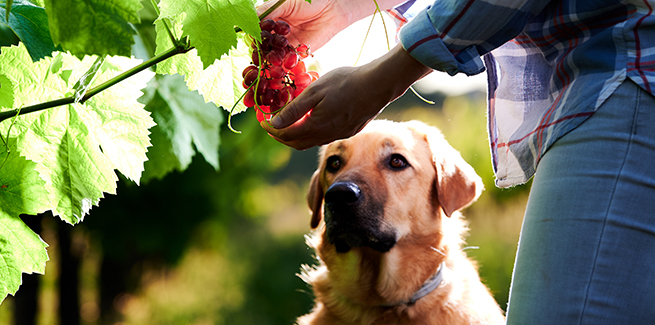What causes grape toxicity in dogs? Playdough might have led to a breakthrough

We’ve known for years that grapes are toxic to dogs. But we didn’t quite know why.
Now we might, and homemade playdough is the reason.
A letter published in the April issue of Journal of the American Veterinary Medical Association and signed by three veterinarians—two of whom work for the American Society for the Prevention of Cruelty to Animals Animal Poison Control Center (APCC)—outlined why.
NEWStat reached out to one of the coauthors, Colette Wegenast, DVM, senior consulting veterinarian in clinical toxicology at the APCC, to find out more.
Wegenast was the first person to make the possible connection between tartaric acid and grapes while managing the case of a dog who ate homemade playdough (more on that later). She then worked with APCC toxicologist Irina Meadows, DVM, to develop and investigate the theory.
NEWStat: We’ve known for 20-plus years that grapes, along with raisins and currants, are poisonous to dogs. Why did it take so long to identify tartaric acid as the toxic agent?
Colette Wegenast: There have been a number of theories about the toxic component of grapes and raisins [but] only some of those have been investigated. Tartaric acid became suspect when the APCC consulted on a case involving [homemade playdough made with] cream of tartar, which contains potassium bitartrate, the potassium salt of tartaric acid. Tartaric acid has a wide margin of safety in humans and common lab animals such as mice, and many of the studies in dogs are outdated, so [tartaric acid] was not previously on the radar as the possible toxic principle.
NEWStat: What are the signs of tartaric acid poisoning?
CW: In dogs, significant vomiting is common, while diarrhea and polydipsia (excessive thirst) may also occur. Acute renal failure is a possible outcome.
NEWStat: A dog who ingested homemade playdough helped point the way for you. Please explain!
CW: Most homemade playdough contains enough salt that dogs will develop severe signs secondary to hypernatremia (a high level of sodium in the blood) if there is significant ingestion, and aggressive fluid therapy is needed. In this case, the playdough contained a smaller amount of salt, so hypernatremia didn’t develop. The dog did develop severe azotemia (high levels of nitrogen in the blood) that was preceded by significant vomiting.
NEWStat: So you had to consider the substitute component in the playdough: cream of tartar. Because the dog wasn’t exhibiting signs of hypernatremia, what was the “lightbulb” moment when you compared the multitude of cases of acute renal failure due to grape toxicity with this case?
CW: The lightbulb moment came with the realization that tartaric acid and potassium bitartrate are uniquely present in high concentrations in grapes, and that dogs are [members of] a species that has been shown to be sensitive to tartaric acid—with acute renal failure reported in the older studies. Upon further investigation [ . . . ] tartaric acid and potassium bitartrate kept checking off the boxes in support of the theory that they’re the toxic principles in grapes and raisins.
NEWStat: What other household products could this discovery point to as potentially toxic for dogs?
CW: Tamarinds [a tree that bears fruit that’s used both in medicine and in cooking] also contain high amounts of tartaric acid and potassium bitartrate, and the APCC has had reports of severe vomiting and acute renal failure following large ingestions.
NEWStat: If tartaric acid is the culprit, how could this impact the future of veterinary toxicology?
CW: We anticipate that this breakthrough will open doors to a collaborative effort toward an improved understanding of grape and raisin poisoning and, potentially, better testing, treatment, and prevention. [We’re] in the process of writing a [paper] that will provide more detailed information to the veterinary community.
So, keep an eye out for more information. In the meantime, if a dog presents for homemade playdough ingestion, AAHA’s chief medical officer, Heather Loenser, DVM, recommends gathering a list of ingredients used from the client. If cream of tartar is present, consider monitoring renal values.
You can find the letter to the editor, “Unique sensitivity of dogs to tartaric acid and implications for toxicity of grapes” in the April 1, 2021, issue of JAVMA, pages 706–707.



